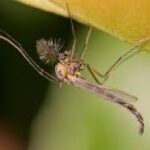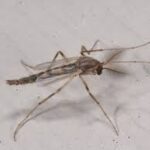 Some shore-side communities can be plagued by massive swarms of adult midges. Sometimes called “blind mosquitoes” or “chizzywinks,” midges are non-biting insects in the fly family that breed in natural and constructed bodies of water (such as retention ponds). The worm-like larvae of midges live in lakes, streams, ponds, drainage ditches, brackish water, and even in polluted wastewater channels. Most species feed on algae, and are in turn fed upon by fish and other aquatic animals. They sometimes build up to phenomenal numbers. Researchers have reported over 40,000 larvae per square meter in a central Florida lake and 20,000 larvae per square meter in southern California “water-spreading basins”! Midges are strongly associated with polluted water.
Some shore-side communities can be plagued by massive swarms of adult midges. Sometimes called “blind mosquitoes” or “chizzywinks,” midges are non-biting insects in the fly family that breed in natural and constructed bodies of water (such as retention ponds). The worm-like larvae of midges live in lakes, streams, ponds, drainage ditches, brackish water, and even in polluted wastewater channels. Most species feed on algae, and are in turn fed upon by fish and other aquatic animals. They sometimes build up to phenomenal numbers. Researchers have reported over 40,000 larvae per square meter in a central Florida lake and 20,000 larvae per square meter in southern California “water-spreading basins”! Midges are strongly associated with polluted water.
Adult midges can swarm up to a quarter mile from where they lived as larvae. During the day, swarms of midges congregate in cool, shady spots, staining building walls and other surfaces with their droppings. In early evening, outdoor activities at lake-front properties can be almost impossible because midges get into the residents’ hair, ears, and eyes. Sometimes, swarms are so dense that you cannot breathe without inhaling midges. Bright lights, particularly security lights shining onto outside walls, bring swarms of midges onto buildings, and midges find their way inside as if by magic.
Insecticides are not usually a practical solution for large midge outbreaks for these reasons:
(1) Potential environmental impacts from insecticides applied into water systems,
(2) The phenomenal numbers of midges emerging every night,
(3) Widespread midge breeding areas, and
(4) The critical control point may be at the bottom of a lake or other large body of water.
There are other options to reduce midge problems. On the next page we present a menu of control options to consider and investigate further if you face a problem with massive swarms of midges. Note: Some of these options are reasonable but untested, community based, expensive, or require long-term commitments.
Light Management. Shield or move outdoor lights away from docks, doorways, pools, patios, and areas where people gather. Reduce the power of lights in critical areas. Direct the beam to shine only where needed. Avoid shining bright lights on light-colored walls. Sodium vapor lights and dichrom yellow bulbs are somewhat less attractive to midges, as are lower wattage bulbs. Leave lights off until at least an hour after sunset to avoid the period of greatest midge activity. At night, close inside curtains or blinds that face breeding areas.
Screens and Buffers. Trees and other screening vegetation, high walls, and other barriers installed between the breeding site and the area at risk can work in a number of ways to reduce midge problems. They can act as a barrier to block the light coming from houses, parking lots, etc. that attracts the midges. They can also intercept windblown midges before they reach critical areas. And trees and other buffers can become habitats for midge predators such as spiders.
Decoy Lights. High intensity lights can be installed to attract midges to noncritical areas and away from critical areas. The lights are typically installed at the water’s edge or even over the water.
Traps. Insect light traps installed between the breeding site and the area at risk (but not too close!) will intercept and kill large numbers of midges and may reduce the number of midges reaching homes and other critical areas. Whether or not the reduction would be significant is unclear. Japanese researchers added the buzz of female wing beats in order to attract male midges and greatly increased Insect Light Traps catches (over 90% of midges in a swarm are males).
Ecosystem Management. Conditions in the body of water determine the midge population. Altering these conditions can reduce midge outbreaks in some instances but tend to be expensive, hard to implement, and subject to state and federal water regulations.
Methods include: Improving water quality. Many midge problems are associated with algal blooms caused by pollutants and nutrients getting into water from food plants, sewage treatment plants, fertilizer runoff and the like. Reducing these pollutants and runoff of nutrients into water can reduce midge problems over the long term.
Improving water circulation. Poor water circulation causes low oxygen levels and traps nutrients that favor algal blooms and high midge populations. Owners can correct dead spots in water bodies through dredging, thinning aquatic vegetation, and altering shorelines. Adding fountains in dead zones will oxygenate water and reduce algal blooms.
Stocking natural fish predators. Some bodies of water have few predators of midge larvae. Stocking fish predators and enhancing the fish environment can increase predation and reduce midge numbers.